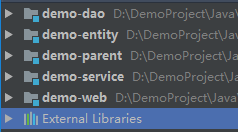一、引入mybatis及mysql的jar包
可以从阿里云上面查找版本,db操作放在dao层所以打开该层的pom.xml文件,找到<dependencies>节点增加两个引入
<dependency> <groupId>org.mybatis</groupId> <artifactId>mybatis</artifactId> <version>3.4.5</version> </dependency> <dependency> <groupId>mysql</groupId> <artifactId>mysql-connector-java</artifactId> <version>5.1.45</version> </dependency>
保存后系统会自动下载对应版本的jar包,我们开始编码
二、配置mybatis(手动创建)

1.在dao层的src/main下创建和java文件夹同级目录的resources文件夹,它默认会变换类型,如果不变则手动调整一下
2.在resources文件夹下创建mysql.properties文件
填入mysql数据库连接信息
jdbc.driver=com.mysql.jdbc.Driver
#数据库连接允许中文需要指明编码方式
jdbc.url=jdbc:mysql://10.11.12.237:3306/tyh_test?useUnicode=true&characterEncoding=utf8
jdbc.username=root
jdbc.password=root
3.在resources文件夹下创建mybatis_cfg.xml文件
填入mybatis配置信息
<?xml version="1.0" encoding="UTF-8"?> <!DOCTYPE configuration PUBLIC "-//mybatis.org//DTD Config 3.0//EN" "http://mybatis.org/dtd/mybatis-3-config.dtd"> <configuration> <!-- 引入配置文件 --> <properties resource="mysql.properties"></properties> <!-- 为Java实体设置类别名 --> <typeAliases> <!-- 设置方式1,一个一个配置 type中放置的是类的全路径,alias中放置的是 类别名 <typeAlias type="com.tyh.entity.UserEntity" alias="UserEntity"/> --> <!-- 设置方式2,自动扫描,将Java类的类名作为类的 类别名 --> <package name="com.tyh.entity"/> </typeAliases> <!-- 配置mybatis运行环境 --> <environments default="dev"> <environment id="dev"> <!-- 代表使用JDBC的提交和回滚来管理事务 --> <transactionManager type="JDBC"/> <!-- mybatis提供了3种数据源类型,分别是:POOLED,UNPOOLED,JNDI --> <!-- POOLED 表示支持JDBC数据源连接池 --> <!-- UNPOOLED 表示不支持数据源连接池 --> <!-- JNDI 表示支持外部数据源连接池 --> <dataSource type="POOLED"> <!-- ${jdbc.driver}代表配置文件中的某一项的key --> <property name="driver" value="${jdbc.driver}"/> <property name="url" value="${jdbc.url}"/> <property name="username" value="${jdbc.username}"/> <property name="password" value="${jdbc.password}"/> </dataSource> </environment> </environments> <!-- 为mybatis的映射文件mapper.xml设置路径 --> <mappers> <!-- 映射方式1,一个一个设置 <mapper resource="com.tyh.dao.mapper.UserMapper.xml"/> --> <!-- 映射方式2,自动扫描包内的Mapper接口与配置文件 --> <package name="com/tyh/dao/mapper"/> </mappers> </configuration>
4.在src/main/java下创建各自的包,我这里是com.tyh.dao.mapper,在mapper文件夹下创建UserMapper的接口文件,用于编写DB操作函数
public interface UserMapper { /** * 添加用户 * @param entity 实体 * @return 添加id * @throws Exception */ int add(UserEntity entity) throws Exception; int delete(int id) throws Exception; int update(UserEntity entity) throws Exception; UserEntity get(int id) throws Exception; List<UserEntity> list() throws Exception; }
5.同样在mapper文件夹下创建UserMapper.xml文件,用于编写与接口函数对应的SQL脚本,此处切记节点属性不要写错,否则会报错
<?xml version="1.0" encoding="UTF-8"?> <!DOCTYPE mapper PUBLIC "-//mybatis.org/DTD Mapper 3.0" "http://mybatis.org/dtd/mybatis-3-mapper.dtd"> <!-- cache 配置给定命名空间的缓存 cache-ref 从其他命名空间引用缓存配置 resultType 返回值类型 resultMap 描述如何从数据库结果集中装载你的对象 parameterType 参数类型 parameterMap 已过时 sql 可重用的SQL语句块 insert 插入语句 update 更新语句 delete 删除语句 select 查询语句 --> <!-- 指明当前xml对应的Mapper --> <mapper namespace="com.tyh.dao.mapper.UserMapper"> <!-- 自定义返回结果集 如果实体属性名与列名一致则不需要此部分,若不一致则需要 --> <!--<resultMap id="userMap" type="UserBean">--> <!--<id property="id" column="id" javaType="java.lang.Integer"></id>--> <!--<result property="username" column="username" javaType="java.lang.String"></result>--> <!--<result property="password" column="password" javaType="java.lang.String"></result>--> <!--<result property="account" column="account" javaType="java.lang.Double"></result>--> <!--</resultMap>--> <!-- 各种标签中的id属性与mapper接口中的方法名一一对应,id属性必须唯一不能重复使用,parameterType属性指明查询时使用的参数类型,resultType属性指明查询返回的结果集类型 --> <!-- #{}中的内容,为占位符,当参数为某个Entity时,表示放置该Entity对象的属性值 --> <!-- useGeneratedKeys:(仅对insert有用)这会告诉MyBatis使用JDBC的getGeneratedKeys方法来取出由数据(比如:像 MySQL 和 SQLServer 这样的数据库管理系统的自动递增字段)内部生成的主键。默认值: false。 --> <!-- keyProperty:(仅对 insert有用)标记一个属性, MyBatis 会通过 getGeneratedKeys或者通过 insert 语句的 selectKey 子元素设置它的值。默认:不设置。 --> <insert id="add" useGeneratedKeys="true" keyProperty="id"> insert into user (username, password, age) values (#{userName},#{password},#{age}); </insert> <delete id="delete" parameterType="int"> delete from user where id=#{id} </delete> <update id="update" > update user set username=#{username}, password=#{password}, age=#{age} where id=#{id}; </update> <!-- select节点必须有resultType属性如果不是自定义结果集就可以直接写实体包名[要含包名的完整类名] --> <select id="get" resultType="com.tyh.entity.UserEntity"> select * from user where id=#{id}; </select> <select id="list" resultType="com.tyh.entity.UserEntity"> select * from user; </select> </mapper>
6.我们在文件夹内添加的xml及properties文件默认编译不会被复制过去,所以运行时会提示找不到文件,在配置中指明要一起打包文件即可
我这个项目有parent模块,所以在父模块中添加配置,子模块会自动继承,如果没有父模块则单独在demo-dao层的pom.xml文件添加也可
<!-- build节点普遍已经存在了,在其下增加resources等节点 --> <build> <!-- 打包文件内容配置 --> <resources> <!-- 将src/main/java下的**/*.xml任意目录下的xml文件打包到对应的文件目录中 --> <resource> <directory>src/main/java</directory> <includes> <include>**/*.xml</include> </includes> </resource> <!-- 将src/main/resources下的**/*.*任意目录下的任意文件打包到对应的文件目录中 --> <resource> <directory>src/main/resources</directory> <includes> <include>**/*.*</include> </includes> </resource> </resources> </build>
7.基础已经准备好了,下面创建数据库Mybatis操作对象,在com.tyh.dao下创建DBTools数据库工具类
public class DBTools { public static SqlSessionFactory sessionFactory; static { try { //使用MyBatis提供的Resources类加载mybatis的配置文件 Reader reader = Resources.getResourceAsReader("mybatis_cfg.xml"); //构建sqlSession的工厂 sessionFactory = new SqlSessionFactoryBuilder().build(reader); } catch (Exception e) { e.printStackTrace(); } } //创建能执行映射文件中sql的sqlSession public static SqlSession getSqlSession(){ return sessionFactory.openSession(); } }
8.编写dao操作层,用于调用底层实现函数
public class UserDao { private SqlSession sqlSession; private UserMapper mapper; public UserDao() { sqlSession = DBTools.getSqlSession(); mapper = sqlSession.getMapper(UserMapper.class); } public int add(UserEntity entity) throws Exception { //调用数据库操作函数后需要commit才会提交 int result = mapper.add(entity); sqlSession.commit(); return result; } public int delete(int id) throws Exception { int result = mapper.delete(id); sqlSession.commit(); return result; } public int update(UserEntity entity) throws Exception { int result = mapper.update(entity); sqlSession.commit(); return result; } public UserEntity get(int id) throws Exception { UserEntity result = mapper.get(id); sqlSession.commit(); return result; } public List<UserEntity> list() throws Exception { List<UserEntity> result = mapper.list(); sqlSession.commit(); return result; } }
至此Dao层的DB操作已经完成,自己编写service和web调用即可,以下是我项目的结构。

注:数据库创建时也需要指明utf8格式编码,否则会出现中文乱码问题
create database test charset utf8;